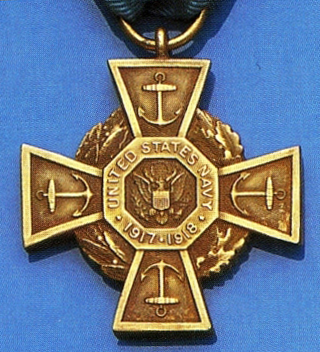| Tiffany Cross Medal of Honor | |
|---|---|
 1919–1942 Navy "Tiffany Cross" pattern | |
| Type | Medal (Decoration) |
| Awarded for | Gallantry and intrepidity in actual conflict at the risk of one's life above and beyond the call of duty |
| Description | Modified cross pattée |
| Presented by | the President of the United States in the name of Congress |
| Eligibility | US Navy and Marine Corps personnel, 1917–1942 |
| Motto | VALOUR |
| Status | Obsolete 7 August 1942 |
| Established | 4 February 1919 (retroactive to 6 April 1917) |
| First awarded | 15 October 1917, World War I |
| Last awarded | 8 January 1928, Nicaragua |
| Total | 22 |
| Total awarded posthumously | 5 |
| Total recipients | 22 |
 Details of the Tiffany Cross | |
| Precedence | |
| Equivalent | Medal of Honor |
| Next (lower) | Navy Distinguished Service Medal[1] |
The Tiffany Cross Medal of Honor arose immediately after World War I, as the US Navy decided to recognize via the Medal of Honor two manners of heroism, one in combat and one in the line of a sailor's profession. The original upside-down star was designated as the non-combat version and a new pattern of the medal pendant, in cross form, was designed by the Tiffany Company in 1919. It was to be presented to a sailor or Marine who "in action involving actual conflict with the enemy, distinguish[es] himself conspicuously by gallantry and intrepidity at the risk of his life above and beyond the call of duty and without detriment to his mission."[2] This pendant became the Tiffany Cross.
- ^ US Naval History & Heritage Command (24 January 2001). "The Navy Cross". Retrieved 25 January 2016.
- ^ US Naval History & Heritage Command (23 January 2008). "80-G-K-13534 World War I U.S. Navy Medal of Honor ("Tiffany Cross" pattern)". Department of the Navy. Retrieved 25 January 2015.